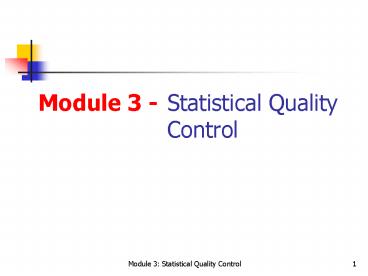Module 3 Statistical Quality Control - PowerPoint PPT Presentation
1 / 22
Title:
Module 3 Statistical Quality Control
Description:
Causes can be identified and eliminated. e.g. poor employee training, worn ... a X-bar Chart: A quality control inspector at the Cocoa Fizz soft drink company ... – PowerPoint PPT presentation
Number of Views:167
Avg rating:3.0/5.0
Title: Module 3 Statistical Quality Control
1
Module 3 - Statistical Quality Control
2
Course Framework
- 1. Cost
- - Design Selection
- 2. Quality
- - TQM
- - SQC
- 3.Speed
- - Project Management
- - Supply Chain
- 4. Flexibility
- - Inventory
- - Location
- - Forecasting
- - Aggregate Planning
3
Learning Objectives
- Understand SPC background
- Identify Control Charts for Variables
- Identify Control Charts for Attributes
4
1. Sources of Variation
- Common causes of variation
- Random causes that we cannot identify
- Unavoidable
- e.g. slight differences in process variables like
diameter, weight, service time, temperature - Assignable causes of variation
- Causes can be identified and eliminated
- e.g. poor employee training, worn tool, machine
needing repair
5
Traditional Statistical Tools
- The Mean- measure of central tendency
- The Range- difference between largest/smallest
observations in a set of data - Standard Deviation measures the amount of data
dispersion around mean
6
Traditional Statistical Tools
- The Mean- measure of central tendency
- The Range- difference between largest/smallest
observations in a set of data - Standard Deviation measures the amount of data
dispersion around mean
7
Traditional Statistical Tools
- The Mean- measure of central tendency
- The Range- difference between largest/smallest
observations in a set of data - Standard Deviation measures the amount of data
dispersion around mean
8
Distribution of Data
- Normal distributions
9
SPC Methods-Control Charts
- Control Charts show sample data plotted on a
graph with CL, UCL, and LCL - Control chart for variables are used to monitor
characteristics that can be measured, e.g.
length, weight, diameter, time - Control charts for attributes are used to monitor
characteristics that have discrete values and can
be counted, e.g. defective, number of flaws in
a shirt, number of broken eggs in a box
10
Setting Control Limits
- Percentage of values under normal curve
11
2. Control Charts for Variables
- Use x-bar and R-bar charts together
- Used to monitor different variables
- X-bar R-bar Charts reveal different problems
- In statistical control on one chart, out of
control on the other chart? OK?
12
2. Control Charts for Variables
- Use x-bar and R-bar charts together
- Used to monitor different variables
- X-bar R-bar Charts reveal different problems
- In statistical control on one chart, out of
control on the other chart? OK?
13
Constructing a X-bar Chart A quality control
inspector at the Cocoa Fizz soft drink company
has taken three samples with four observations
each of the volume of bottles filled. If the
standard deviation of the bottling operation is
.2 ounces, use the below data to develop control
charts with limits of 3 standard deviations for
the 16 oz. bottling operation.
- Center line and control limit formulas
14
Solution and Control Chart (x-bar)
- Center line (x-double bar)
- Control limits for3s limits
15
X-bar Control Chart
16
Control Chart for Range (R)
- Center Line and Control Limit formulas
17
R Control Chart
18
3. Control Charts for Attributes
- Use P-Charts for quality characteristics that are
discrete and involve yes/no or good/bad decisions - Number of leaking caulking tubes in a box of 48
- Number of broken eggs in a carton
- Use C-Charts for discrete defects when there can
be more than one defect per unit - Number of flaws or stains in a carpet sample cut
from a production run - Number of complaints per customer at a hotel
19
P-Chart Example A Production manager for a tire
company has inspected the number of defective
tires in five random samples with 20 tires in
each sample. The table below shows the number of
defective tires in each sample of 20 tires.
Calculate the control limits.
- Solution
20
P-Control Chart
21
C-Chart Example The number of weekly customer
complaints are monitored in a large hotel using a
c-chart. Develop three sigma control limits
using the data table below.
- Solution
22
C-Control Chart

